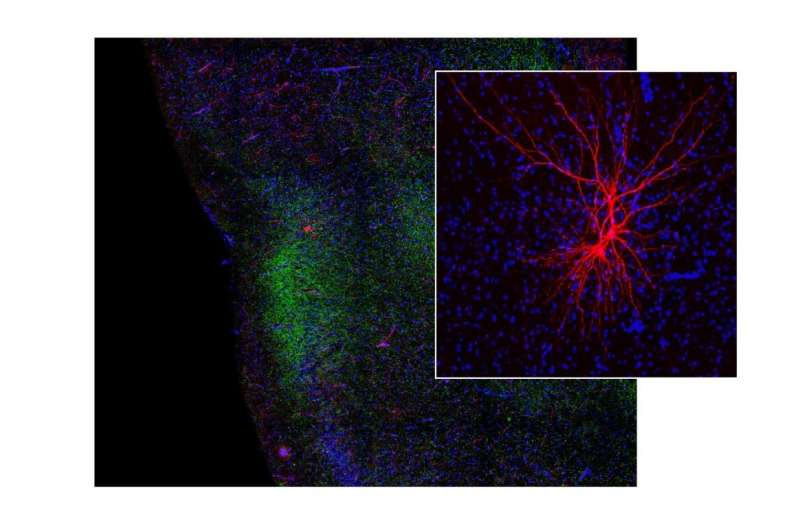This photo shows a section of the gustatory cortex and the input from the basolateral amygdala. Blue indicates all of the neurons in the gustatory cortex, green corresponds to the connection from the amygdala to the gustatory cortex, and red indicates the recorded neurons in the experiments (magnified in right box). Credit: Stony Brook University
A new study showing how a stomach ache associated with a novel, appealing food forms an aversion to that food also reveals how areas of the brain may work together to alter behavior based on good or bad experiences. Led by Stony Brook University researchers, the study is published in eLife.
The study involved conditioning rats to dislike the taste of sugar water, something they normally would like, by creating a mild digestive malaise after consumption. A powerful memory is formed when a pleasant taste is associated gastrointestinal pain, similar to an experience with food poisoning that results in an aversion to that food. How the brain works in this process to form a long lasting memory has been debated by scientists.
According to Arianna Maffei, Ph.D., Senior Author and Professor in the Department of Neurobiology and Behavior in the College of Arts and Sciences and Renaissance School of Medicine at Stony Brook University, the areas of the brain involved in this form or learning—the basolateral amygdala and the portion of the insular cortex involved in taste processing (gustatory cortex) have been known for some time, but there is no clear understanding of how they may work together during learning.
Maffei, Melissa Haley, a postdoctoral fellow in the Maffei Lab, and colleagues investigated the neural mechanisms behind the taste aversion response. They used optogenetics, a technique that combines light and genetic information to control neurons in the brain and recorded behavioral reactions and neural pathways involved in taste and threat.
They discovered that conditioned taste aversion learning decreases the strength of the synaptic connection between basolateral amygdala and gustatory cortex and leads to an overall decreased activation of neurons in the gustatory cortex—a different process from the widely accepted idea that to form a memory, neurons need to be active at the same time.
"Our experiments provide the first direct evidence that learning to avoid certain tastes depends on the long-term reduction in the activity in connections between taste and threat sensors in the brain," says Haley. "The findings also suggest reducing the activity between two brain centers can be an important way in which animals learn other behaviors, which adds to our understanding of the processes that enable the formation of memories and lead to changes in behavior."
"These results link reduced communication between the taste and threat-processing centers to a change in taste preference and shows that changes in communication between brain centers can influence the way animals perceive and behave toward things that make them feel good or bad," says Maffei.
Both Haley and Maffei emphasize that the discovery could have broader implications in the area of neurobiology intervention for helping people to break addictions to harmful substances. They say additional research may provide further evidence on how these regions of the brain work toward taste and other related aversions.
More information: Melissa S Haley et al. LTD at amygdalocortical synapses as a novel mechanism for hedonic learning, eLife (2020). DOI: 10.7554/eLife.55175
Journal information: eLife
Provided by Stony Brook University
























